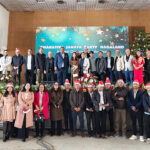Mokokchung Times News | July 21
The NITI Aayog’s India Innovation Index 2021 (III 2021) released today recorded Nagaland with a score of 11 which ranked at bottom ten in the Northeastern and Hill States Category.

The India Innovation Index ranks 36 Indian states based on innovation scorescalculated by measuring the enabler (Human Capital, Investment, Knowledge Workers, Business Environment, and Safety and Legal Environment) and performer(Knowledge Output and Knowledge Diffusion) dimensions.
Nagaland scored 19.69 on enablers but just 2.31 on performers, indicating that the enablers weren’t utilized to their full potential. Nagaland and Tripura had the lowest overall scores as a result of their underutilized talent, as shown by their poor human capital and business environment performance, which shows that their innovative skills have not been fully used.
The creativity, skills, and habits required for a region’s socioeconomic development come from its human capital. A state’s ability for innovation is mostly determined by its educational level and quality.
School education and tertiary and higher education are the two components of this pillar. Nagaland is a state with a smaller population, hence it is recommended that more efforts be made to invest in the development of human capital by encouraging the enrollment in high-quality educational institutions, engineering and technology universities, and vocational training courses.
Nagaland also scored less than the national average in the “Business Environment” pillar. The report said,” States cannot enable innovative systems without addressing deficiencies in their existing business ecosystem.States urgently need to enhance their outcomes in categories in which they are lagging behind, so as to come at par with the other states. This would uplift their respective performance and improve the country’s overall business environment.”
All of the Northeastern and Hilly States, as well as the Union Territories and City/States, are the best performers in terms of safety and the legal environment. This does not necessarily imply a more secure and stable legal environment, though. According to the report,”alower rate of offences under IT/IP acts can also be associated with inadequate reporting of such cases.”
One of the output-based pillars that covers all the elements that go into producing the results of innovation is Knowledge Output. It contains indications such as patents, trademarks, industrial designs with provenance, etc. that are the outcome of creative and innovative activity reported by the state. Except for Uttarakhand, the majority of the hilly and northeastern states scored below the national average.
A state’s ability to absorb knowledge is mirrored by Knowledge Diffusion. Knowledge dissemination and the production of creative goods and services are its two sub-pillars. The pillar represents a state’s attempts to transition from a factor-driven to an innovation-driven economy. Knowledge Dissemination covers measures such as software exports, high-tech exports, high and medium-high tech manufacturing organizations, and citations that are all connected to industries with high-tech content or that are essential to innovation.
In Northeast and hilly regions, it was observed that they lag behind in parameters such as ICT exports, citations, handloom sales and hi-tech manufacturing entities. Therefore, only Uttarakhand (10.16), Himachal Pradesh (7.14) and Manipur (8.66) have scored above the national average.
“States need to bolster their efforts in bridging gaps within their export ecosystem, which will result in potential gains, which may lead to spillovers in the region,” the report said.
Nagaland’s performance during the previous year wasn’t much better, hence they were unable to significantly reduce their distance from the frontier (DTF) deficit.
However, Nagaland significantly increased the number of Ph.D. enrollments and the percentage of schools with ICT laboratories (per lakh population). Other than this, no other indicator showed improvement.
This may be seen in its “performers,” where several metrics from the Knowledge Output pillar showed only modest progress.
Building a strong framework to encourage innovation, whether it takes the shape of incentives, funding, or the creation of specialized institutions, among other forms, is vital for Nagaland and its counterparts.
The unique challenges that these states face, such as their geographical location, which constraints them from getting better connectivity and infrastructure, do not preclude them from innovating, as states such as Manipur and Uttarakhand have nurtured innovation by creating a conducive and sustainable environment for innovation.
“It is a known fact that all the Northeastern and Hilly States have very few start-ups and they all need measures for entrepreneurs to invest and innovate in these states. Therefore, reflective learning along with a holistic approach is a way forward for these states,” the report added.
Karnataka, Manipur and Chandigarh tops NITI Aayog’s India Innovation Index-3
Karnataka, Manipur and Chandigarh have topped in their respective categories in the third edition of NITI Aayog’s India Innovation Index. NITI Aayog Vice Chairman Suman Bery today released the index in New Delhi. The India Innovation Index is a comprehensive tool for the evaluation and development of the country’s innovation ecosystem. It ranks the States and Union Territories on their innovation performance to build healthy competition amongst them. Karnataka has once again topped the Major States category, while Manipur is leading the North East and Hill States category. Chandigarh is the top performer in the Union Territories and City States category.



